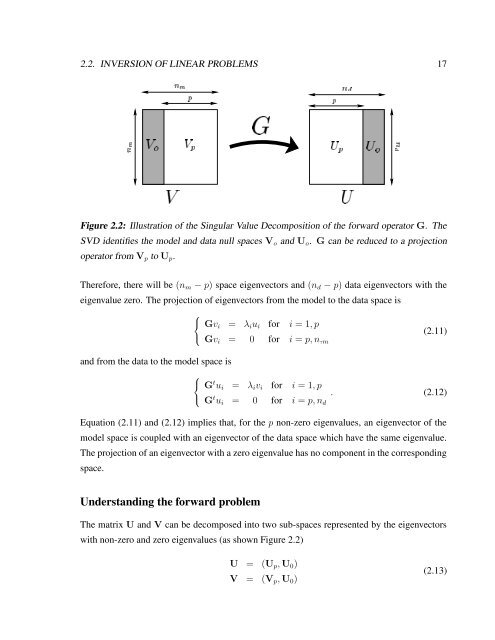Sirgue, Laurent, 2003. Inversion de la forme d'onde dans le ...
Sirgue, Laurent, 2003. Inversion de la forme d'onde dans le ...
Sirgue, Laurent, 2003. Inversion de la forme d'onde dans le ...
You also want an ePaper? Increase the reach of your titles
YUMPU automatically turns print PDFs into web optimized ePapers that Google loves.
£<br />
2.2. INVERSION OF LINEAR PROBLEMS 17<br />
¤¦¥ §©¨<br />
¡ ¢<br />
<br />
<br />
<br />
<br />
Figure 2.2: Illustration of the Singu<strong>la</strong>r Value Decomposition of the forward operator G. The<br />
SVD i<strong>de</strong>ntifies the mo<strong>de</strong>l and data null spaces V o and U o . G can be reduced to a projection<br />
operator from V p to U p .<br />
Therefore, there will be (n m − p) space eigenvectors and (n d − p) data eigenvectors with the<br />
eigenvalue zero. The projection of eigenvectors from the mo<strong>de</strong>l to the data space is<br />
⎧<br />
⎨<br />
and from the data to the mo<strong>de</strong>l space is<br />
⎩<br />
⎧<br />
⎨<br />
⎩<br />
Gv i = λ i u i for i = 1, p<br />
Gv i = 0 for i = p, n, m<br />
(2.11)<br />
G t u i = λ i v i for i = 1, p<br />
G t u i = 0 for i = p, n d<br />
. (2.12)<br />
Equation (2.11) and (2.12) implies that, for the p non-zero eigenvalues, an eigenvector of the<br />
mo<strong>de</strong>l space is coup<strong>le</strong>d with an eigenvector of the data space which have the same eigenvalue.<br />
The projection of an eigenvector with a zero eigenvalue has no component in the corresponding<br />
space.<br />
Un<strong>de</strong>rstanding the forward prob<strong>le</strong>m<br />
The matrix U and V can be <strong>de</strong>composed into two sub-spaces represented by the eigenvectors<br />
with non-zero and zero eigenvalues (as shown Figure 2.2)<br />
U = (U p , U 0 )<br />
V = (V p , U 0 )<br />
(2.13)

















